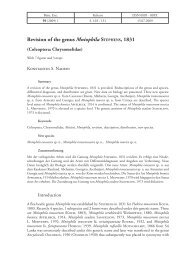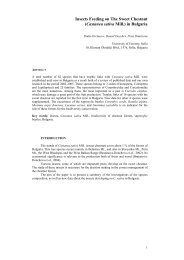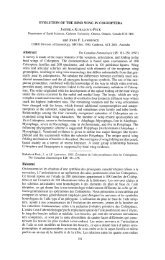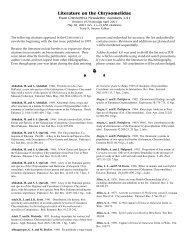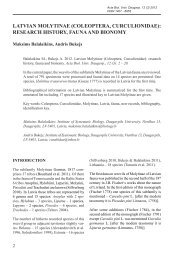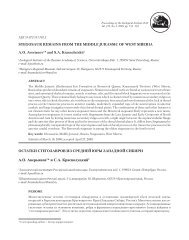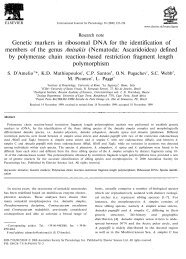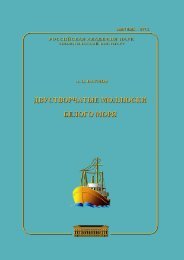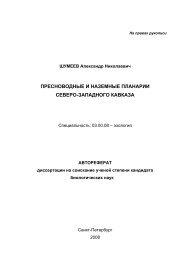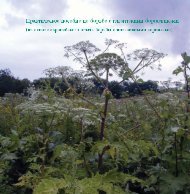International Meeting on Biology and Systematics of Staphylinidae
International Meeting on Biology and Systematics of Staphylinidae
International Meeting on Biology and Systematics of Staphylinidae
Create successful ePaper yourself
Turn your PDF publications into a flip-book with our unique Google optimized e-Paper software.
22nd <str<strong>on</strong>g>Internati<strong>on</strong>al</str<strong>on</strong>g> <str<strong>on</strong>g>Meeting</str<strong>on</strong>g> <strong>on</strong> <strong>Biology</strong> <strong>and</strong> <strong>Systematics</strong> <strong>of</strong> <strong>Staphylinidae</strong> 2007 – abstracts<br />
Aspects <strong>of</strong> the head morphology in staphylinid beetles<br />
DANIELA WEIDE<br />
Eberhard Karls University <strong>of</strong> Tuebingen, Department <strong>of</strong> Evoluti<strong>on</strong>ary <strong>Biology</strong> <strong>of</strong> Invertebrates,<br />
Auf der Morgenstelle 28 E, 72076 Tuebingen, Germany<br />
e-mail: b8weda@yahoo.de<br />
Betz et al. (2003) published a study regarding the questi<strong>on</strong> <strong>of</strong> the widespread feeding<br />
type <strong>of</strong> sporophagy, which means feeding <strong>on</strong> fungal spores or <strong>on</strong> pollen. I investigate whether<br />
this specialized feeding type is mirrored by the head anatomy especially <strong>of</strong> members <strong>of</strong> the<br />
aleocharine subfamily.<br />
To comparatively investigate a large number <strong>of</strong> species we use a novel technique, synchrotr<strong>on</strong><br />
x-ray micro-tomography, which will be shortly introduced. To give you an idea <strong>of</strong><br />
the results achieved using this method, different examples like 3D models or virtual slices<br />
will be shown.<br />
Both, the occurrence <strong>and</strong> the course <strong>of</strong> the muscles <strong>of</strong> the head <strong>and</strong> the c<strong>on</strong>diti<strong>on</strong>s <strong>of</strong> the<br />
inner head skelet<strong>on</strong> (tentorium, sclerites) will be presented. In staphylinids the latter show an<br />
interesting diversity that appears to be hardly homologizable with the structures described for<br />
the orthopteroid groundplan (e.g., Snodgrass, 1993, Matsuda, 1965).<br />
Synchrotr<strong>on</strong>-µCT-Techniques in Arthropod Morphology<br />
DANIELA WEIDE 1) , PAAVO BERGMANN, SEBASTIAN SCHMELZLE & OLIVER BETZ 2)<br />
Eberhard Karls University <strong>of</strong> Tuebingen, Department <strong>of</strong> Evoluti<strong>on</strong>ary <strong>Biology</strong> <strong>of</strong> Invertebrates,<br />
Auf der Morgenstelle 28 E, 72076 Tuebingen, Germany<br />
1) e-mail: b8weda@yahoo.de, 2) e-mail: oliver.betz@uni-tuebingen.de<br />
Using Synchrotr<strong>on</strong> radiati<strong>on</strong> to solve protein structure (protein crystallography) is well<br />
known, whereas in other biological fields such as morphology or physiology this technique is<br />
not as yet very comm<strong>on</strong>.<br />
Synchrotr<strong>on</strong> X-ray micro-tomography (µCT) is a n<strong>on</strong>-invasive technique that gives the<br />
researcher the possibility to obtain virtual thin secti<strong>on</strong>s <strong>of</strong> the object under study with a resoluti<strong>on</strong><br />
close to that <strong>of</strong> the light microscope. These data can be rec<strong>on</strong>structed as 3D models, so<br />
that the scientist is able to study internal structures in their natural positi<strong>on</strong>.<br />
We illustrate some examples from our own research using Synchrotr<strong>on</strong> X-ray microtomography,<br />
e.g. the anatomy <strong>of</strong> beetle heads with respect to muscles <strong>and</strong> inner skelet<strong>on</strong><br />
structures, <strong>and</strong> the reproductive system <strong>of</strong> oribatid mites with special attenti<strong>on</strong> to s<strong>of</strong>t tissue.<br />
We will finally compare histological secti<strong>on</strong>s with data obtained by using Synchrotr<strong>on</strong><br />
µCT techniques.<br />
__________________________________________________________________________________________<br />
Staatliches Museum für Naturkunde Stuttgart 19




